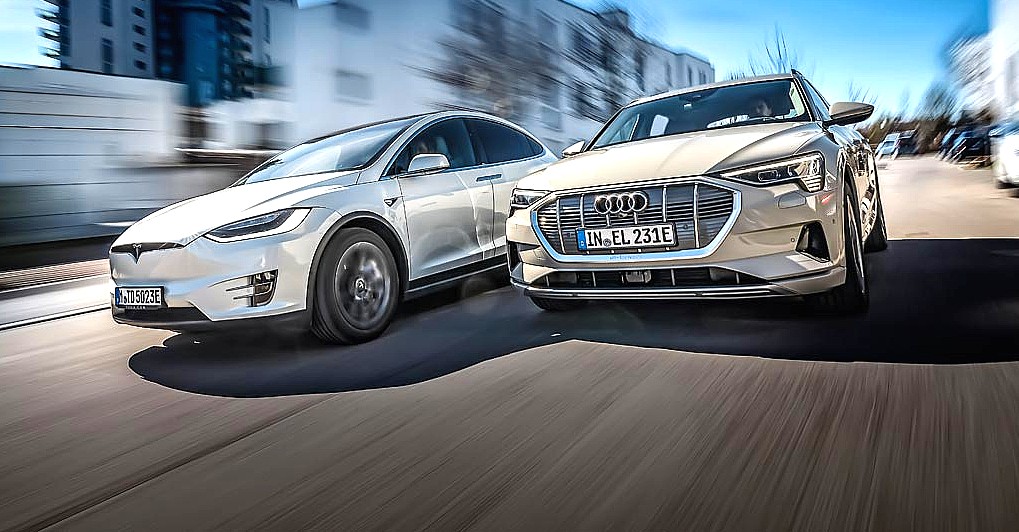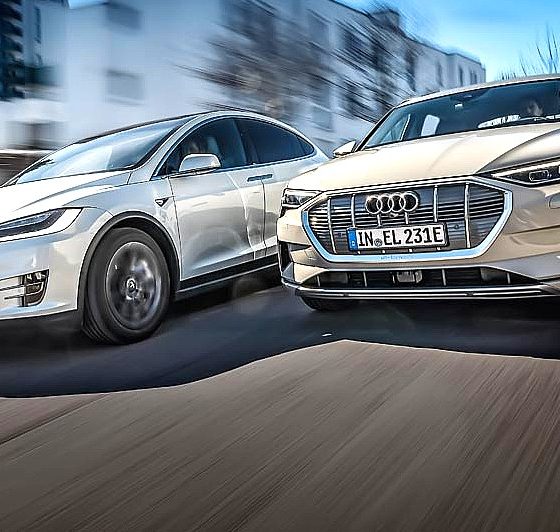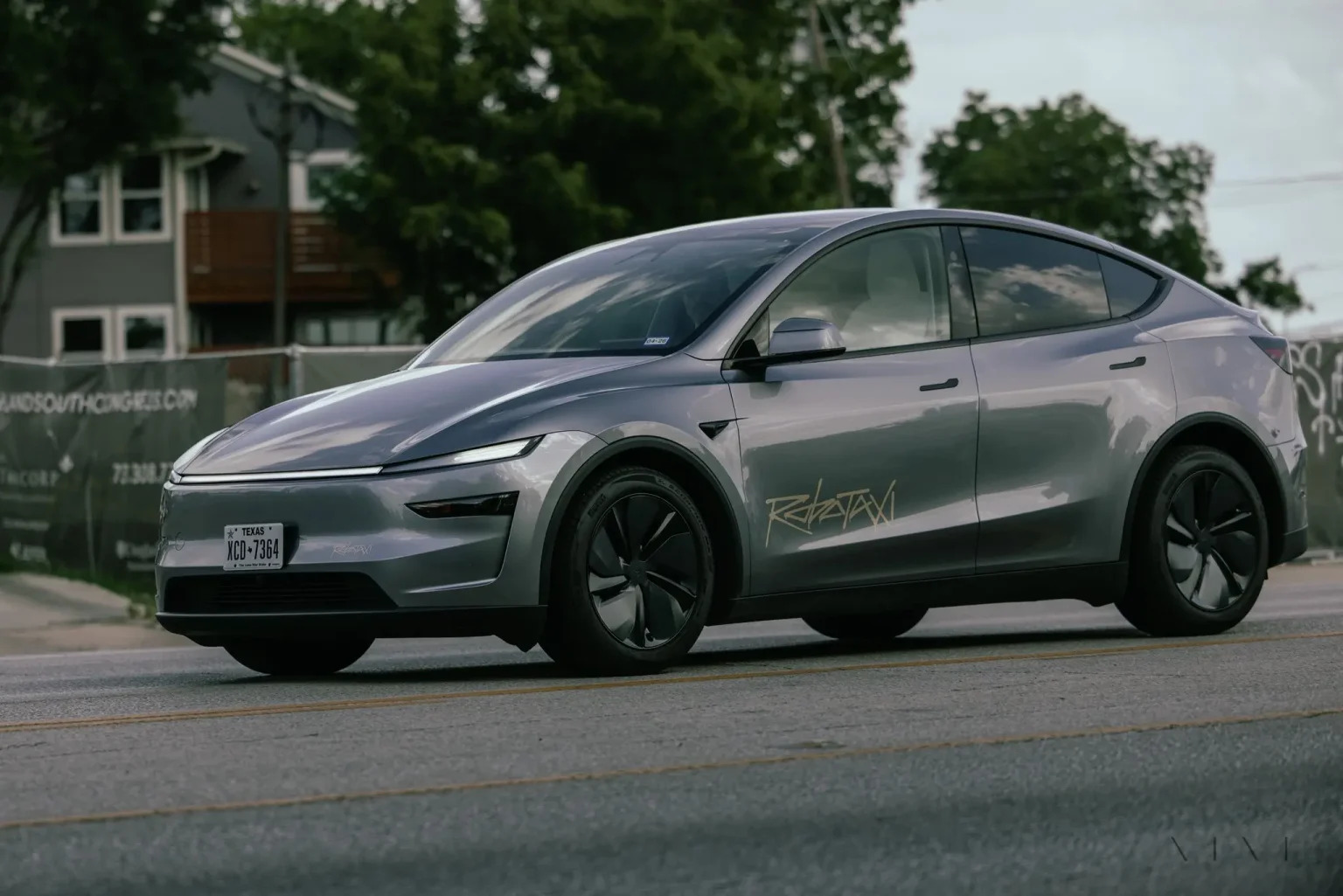

News
Audi e-tron will ‘give Tesla shoppers a run for their money,’ says Consumer Reports
When Consumer Reports published its first impressions of the Audi e-tron, the organization proved quite optimistic about the German carmaker’s all-electric SUV. In a recently uploaded video, Consumer Reports‘ Mike Quincy, Jon Linkov, and Jennifer Stockburger provided more insights about their experience with the e-tron, covering several aspects of the vehicle such as its design, its range, and how it stacks up in comparison to the Tesla Model X.
Consumer Reports auto journalist Mike Quincy praised the vehicle, noting that the Audi e-tron is the “nicest EV I’ve ever driven” to date. “I like it more than any of the Teslas we’ve driven,” he said. The e-tron also earned some applause for its design, such as its rather conventional interior that follows the theme of Audi’s other vehicles. The SUV’s spaciousness and quietness on the road were also lauded.
The driving dynamics of the vehicle also received some praise, with Director of Operations at the CR Auto Test Center Jennifer Stockburger noting that the SUV performs very well as soon as it’s in motion. Commenting further, Consumer Reports Deputy Content Editor Jon Linkov stated that contrary to the snap of acceleration found in Tesla’s electric cars like the Model S, the Audi e-tron has “more of an elegant pull-away.”
Consumer Reports did have a number of negative comments about the e-tron, particularly on its range and price. At $80,000, Quincy noted that the e-tron seems too expensive for a vehicle that features such a limited range, though it was mentioned that perhaps the SUV’s real-world range was being underestimated. Other quirks of the SUV, such as a gear shifter that is a magnet for wrong inputs, were also mentioned as points for improvement. Linkov, for his part, argued that perhaps the limited range of the e-tron would be a non-issue for its target demographic.
“It may be that the market for this doesn’t take family road trips. They may fly. Electric cars today still make a case, particularly $80,000 ones, for a second car. Now there are a lot of people out there, and there are stories online about people, they own a Chevy Bolt, or they own a Leaf, and that’s their only car, and they still run into those headaches of ‘my gosh, I have to stop and charge it’ and it certainly is a case today depending on what you want out of an electric car,” he said.
In conclusion, Consumer Reports remained quite optimistic about the e-tron’s chances on the market, particularly as it is coming from a well-known company that’s known for good quality vehicles. This, according to Stockburger, is something that Tesla buyers might not have yet. “Do I think it’s gonna give Tesla shoppers a run for their money? Oh yeah. And I think there’s a confidence to be had from a mainstream manufacturer building this car, one with a ton of history, good quality, and I think there might be some confidence in the e-tron that maybe you don’t have in a Tesla,” she said.
Curiously enough, several updates on the e-tron remain unsaid in Consumer Reports‘ recent video, such as the ongoing recall for the SUV due to a potential fire risk. The range challenges of the e-tron have also been documented extensively, even by foreign organizations such as nextmove from Germany; and so far, reviews of the SUV which concluded that the vehicle’s range is being underestimated seem to be quite scarce.
The comparisons with the Model X also seemed quite interesting, considering that there was no mention of the recent update that Tesla rolled out into the SUV, which increased its range to 325 miles per charge using a battery that is only 5 kWh larger than the pack utilized by the e-tron. Long trips in an all-electric car have been addressed for years by the Supercharger Network, which allows Tesla’s vehicles to recharge their batteries during quick stops on the road.
Watch Consumer Reports‘ discussion on its Audi e-tron first impressions in the video below.

Elon Musk
SpaceX issues statement on Starship V3 Booster 18 anomaly
The incident unfolded during gas-system pressure testing at the company’s Massey facility in Starbase, Texas.

SpaceX has issued an initial statement about Starship Booster 18’s anomaly early Friday. The incident unfolded during gas-system pressure testing at the company’s Massey facility in Starbase, Texas.
SpaceX’s initial comment
As per SpaceX in a post on its official account on social media platform X, Booster 18 was undergoing gas system pressure tests when the anomaly happened. Despite the nature of the incident, the company emphasized that no propellant was loaded, no engines were installed, and personnel were kept at a safe distance from the booster, resulting in zero injuries.
“Booster 18 suffered an anomaly during gas system pressure testing that we were conducting in advance of structural proof testing. No propellant was on the vehicle, and engines were not yet installed. The teams need time to investigate before we are confident of the cause. No one was injured as we maintain a safe distance for personnel during this type of testing. The site remains clear and we are working plans to safely reenter the site,” SpaceX wrote in its post on X.
Incident and aftermath
Livestream footage from LabPadre showed Booster 18’s lower half crumpling around the liquid oxygen tank area at approximately 4:04 a.m. CT. Subsequent images posted by on-site observers revealed extensive deformation across the booster’s lower structure. Needless to say, spaceflight observers have noted that Booster 18 would likely be a complete loss due to its anomaly.
Booster 18 had rolled out only a day earlier and was one of the first vehicles in the Starship V3 program. The V3 series incorporates structural reinforcements and reliability upgrades intended to prepare Starship for rapid-reuse testing and eventual tower-catch operations. Elon Musk has been optimistic about Starship V3, previously noting on X that the spacecraft might be able to complete initial missions to Mars.
Investor's Corner
Tesla analyst maintains $500 PT, says FSD drives better than humans now
The team also met with Tesla leaders for more than an hour to discuss autonomy, chip development, and upcoming deployment plans.

Tesla (NASDAQ:TSLA) received fresh support from Piper Sandler this week after analysts toured the Fremont Factory and tested the company’s latest Full Self-Driving software. The firm reaffirmed its $500 price target, stating that FSD V14 delivered a notably smooth robotaxi demonstration and may already perform at levels comparable to, if not better than, average human drivers.
The team also met with Tesla leaders for more than an hour to discuss autonomy, chip development, and upcoming deployment plans.
Analysts highlight autonomy progress
During more than 75 minutes of focused discussions, analysts reportedly focused on FSD v14’s updates. Piper Sandler’s team pointed to meaningful strides in perception, object handling, and overall ride smoothness during the robotaxi demo.
The visit also included discussions on updates to Tesla’s in-house chip initiatives, its Optimus program, and the growth of the company’s battery storage business. Analysts noted that Tesla continues refining cost structures and capital expenditure expectations, which are key elements in future margin recovery, as noted in a Yahoo Finance report.
Analyst Alexander Potter noted that “we think FSD is a truly impressive product that is (probably) already better at driving than the average American.” This conclusion was strengthened by what he described as a “flawless robotaxi ride to the hotel.”
Street targets diverge on TSLA
While Piper Sandler stands by its $500 target, it is not the highest estimate on the Street. Wedbush, for one, has a $600 per share price target for TSLA stock.
Other institutions have also weighed in on TSLA stock as of late. HSBC reiterated a Reduce rating with a $131 target, citing a gap between earnings fundamentals and the company’s market value. By contrast, TD Cowen maintained a Buy rating and a $509 target, pointing to strong autonomous driving demonstrations in Austin and the pace of software-driven improvements.
Stifel analysts also lifted their price target for Tesla to $508 per share over the company’s ongoing robotaxi and FSD programs.
Elon Musk
SpaceX Starship Version 3 booster crumples in early testing
Photos of the incident’s aftermath suggest that Booster 18 will likely be retired.

SpaceX’s new Starship first-stage booster, Booster 18, suffered major damage early Friday during its first round of testing in Starbase, Texas, just one day after rolling out of the factory.
Based on videos of the incident, the lower section of the rocket booster appeared to crumple during a pressurization test. Photos of the incident’s aftermath suggest that Booster 18 will likely be retired.
Booster test failure
SpaceX began structural and propellant-system verification tests on Booster 18 Thursday night at the Massey’s Test Site, only a few miles from Starbase’s production facilities, as noted in an Ars Technica report. At 4:04 a.m. CT on Friday, a livestream from LabPadre Space captured the booster’s lower half experiencing a sudden destructive event around its liquid oxygen tank section. Post-incident images, shared on X by @StarshipGazer, showed notable deformation in the booster’s lower structure.
Neither SpaceX nor Elon Musk had commented as of Friday morning, but the vehicle’s condition suggests it is likely a complete loss. This is quite unfortunate, as Booster 18 is already part of the Starship V3 program, which includes design fixes and upgrades intended to improve reliability. While SpaceX maintains a rather rapid Starship production line in Starbase, Booster 18 was generally expected to validate the improvements implemented in the V3 program.
Tight deadlines
SpaceX needs Starship boosters and upper stages to begin demonstrating rapid reuse, tower catches, and early operational Starlink missions over the next two years. More critically, NASA’s Artemis program depends on an on-orbit refueling test in the second half of 2026, a requirement for the vehicle’s expected crewed lunar landing around 2028.
While SpaceX is known for diagnosing failures quickly and returning to testing at unmatched speed, losing the newest-generation booster at the very start of its campaign highlights the immense challenge involved in scaling Starship into a reliable, high-cadence launch system. SpaceX, however, is known for getting things done quickly, so it would not be a surprise if the company manages to figure out what happened to Booster 18 in the near future.








